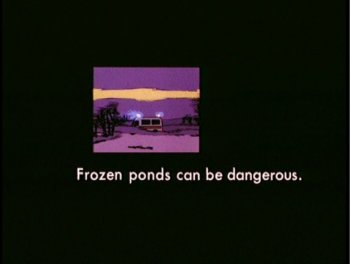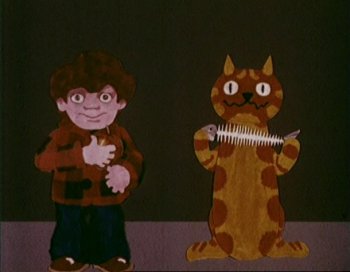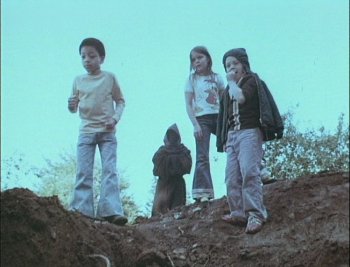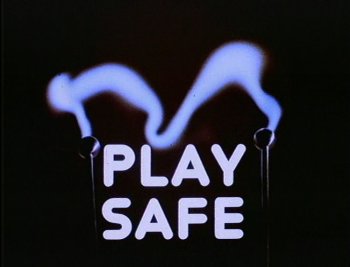The Good Old Days? - Play Safe
Ah, the joys of parenthood. There's no shortage of literature and broadcast media exclaiming the happiness and satisfaction that a child can bring. But parenting has a dark side. With the joy comes responsibility, and, in most cases, a intense desire to protect the child in your care. It's a tough job, which is why the COI were happy to help. Here are PIFs that either gave warnings to children themselves (often played in school assemblies), or their carers.
Tufty Club (c1961)
Tufty Fluffytail is stopped from coming a cropper on the roads by Mr Wise Owl, and with Policeman Badger, the owl starts up the Tufty Club to tell children under five how to not get hurt on the roads, with Tufty being the first member. He's got to cough up half a crown like everyone else, though! This is in a style typical of the time, i.e. it's awfully stilted and dictatorial. The actual content sent to children was displayed in the Charley Says exhibition in Honiton, Devon in early 2008; picture books and badges were the order of the day.
 |
Iced Ponds (1969)/Frozen Ponds (1980)
"Iced Ponds" is a instructional PIF for children dressed up as a fairy story; the children who obeyed the three rules (taking an adult with them, getting the adult to check the ice first, and playing close to the shore, away from the middle, where the ice is thinnest) lived happily ever after, and those who did not obey the rules; well, some of them were never heard of again. Frozen Ponds is a far more depressing PIF aimed at adults, with animation of ambulancemen picking up the body of a unfortunate boy who went further away from the shore than his friends and got trapped under the ice. One of the ambulancemen is explaining the event to his superior, explaining that the boy's mother thought he'd be safe with his friends, and never dreamed it could be that dangerous. The PIF gives the three rules from the parents' perspective at the end. Modern advice is to not to take the risk of playing on frozen ponds at all.
Tell Mummy (1969)/Don't Talk to Strangers (1969)
A common tactic in 'stranger danger' campaigns is to use child voiceovers to give the message from the child's perspective. This uses childish drawings as well to tell a story of a girl who was asked on a picnic by two other children, but couldn't go because she knew she had to ask her mother first, and couldn't get her attention before the other two children left. The girl gets a picnic with her parents as a reward after explaining her distress to her mother. 'Don't Talk to Strangers', from the same animation company, features a girl talking about her brother George, who refused offers from a stranger because he'd remembered what he'd been taught about never talking to strangers. An adult voice reinforces the message at the end.
Children and Disused Fridges (1971)
It's always nice when health and safety laws mean that a PIF is no longer relevant. This warned against the locking mechanisms of old fridges when they were dumped, as they posed a danger to children. Any fridge that was abandoned was airtight and impossible to open from the inside, meaning that some unfortunate children presumably lost their lives when they mistook them for a play den. The magnet seal on fridges, used for some years now, means this could not happen today.
Teenagers Learn to Swim (1972)
Some little teenage minx goes off her boyfriend when she realises he can't swim, and decides to go out with a boy who can. This PIF amusingly shows the social benefits of learning to swim.
Keep Out (1972)
This was another PIF often shown in schools, concentrating on the dangers of playing on railway lines. The shocked expression of the boy at the end is all you need to tell you that his friend has just found out what happens when you fall in front of a train. Despite all the warnings, some children still think railways are an appropiate playground, sometimes with tragic results.
 |
Charley - Matches/Falling in the Water/In the Kitchen/Teapots/Strangers/Mummy Should Know (1973)
This series of PIFs are probably the most famous of their kind; hence why the DVD collection is named after them. The celebration of Charley (a boy's cat who shows him the dangers of the world around them) started with the Prodigy sampling Charley's strangulated miaowing and the boy saying "Charley says; always tell your mummy before you go off somewhere." for the track 'Charly', released in 1991. This inspired copycat singles such as 'A Trip to Trumpton', which sampled the fine children's series Trumpton, with the unforgettable firemen Hugh, Pugh, Barney McGrew, Cuthbert, Dribble and Glub, and 'Sesame's Treet'. I probably don't have to explain the plots of these PIFs, as the titles are fairly self-explanatory. What IS well worth knowing is that Kenny Everett provided the voice for Charley, along with other sound effects, and had actually provided a voice for Charley's owner, but the animators felt it wasn't quite appropiate. An actual young boy played the role instead. In the 'Charley Says' exhibition mentioned above, the original invoice from Kenny's company 'The Wireless Workshop' was displayed, along with more detailed information about the series. If you're over 25 and don't remember Charley, you either grew up abroad, or you had a VERY deprived childhood. All the bad things happened to Charley so his owner didn't need to suffer. He was a bit like Jesus in that respect. And one other.
Under 5's - Shopping (1973)
More Tufty. This isn't specifically about stranger danger; instead, silly Tufty gets distracted whilst out shopping with his mother, and finds himself near the road on his own. Luckily, she turns up very quickly and tells him not to let go of her hand when they're out shopping. "Tufty holds his mummy's hand, and feels safe again." And so he should.
One of the most memorable child abductions in the UK happened because a toddler got separated from his mother in a busy shopping centre. It remains a iconic case because the abductors were children themselves, and the CCTV footage show them leading the 3 year-old James Bulger out of Bootle Shopping Centre to an eventual death on a railway line. The two boys, despite being 10 years old and so below the age of criminal responsibility at the time (unless it could be proved that they knew the difference between right and wrong), were trialed in an adult court, and sentenced to a minimum of 10 years in a Young Offenders' Institution. The impact of the case on the public consciousness can be shown by the coverage in the tabloid press, which seemed to want nothing less than the death penalty for these two very disturbed boys (a Sun campaign succeeded in getting the Home Secretary to increase the sentence to a minimum of 15 years, but this was overturned at the Courts of Appeal), and the howls of outrage when they were released as young adults in June 2001 under a life licence, with different identities, despite there being precendent for such treatment (see the Mary Bell case). The recent Facebook 'Super Wall' post that went around recently shows the remaining public appetite for pursuing these two men, proffessing outrage at their proposed release, when in reality they had been released several years previously. It's extraordinary in the cold light of day to consider that there isn't nearly half as much outrage over the release of adults who kill children, despite these adults presumably having far more understanding of their actions. I'm a very different person from when I was 10 years old, and I have every reason to believe that Jon Venables and Robert Thompson will have changed as well. Unfortunately, some people can't get past the heinous act they committed when vulnerable children, and these two men are no doubt living a life with an eye always over one shoulder, rather than the charmed existence that some tabloid reporters would have us believe.
An interesting side issue to this case is that it happened after toddler reins went out of fashion, something I remember wearing at around 3-4 years old. An industry sprung up soon after the case selling wrist links, so panic-stricken mothers could ensure that their charges couldn't wriggle out of reach.
 |
Lonely Water (1973)
A friend of mine thinks that the voiceover for this PIF is done by James Bolam, pretending to be Donald Pleasance. It warns children to treat water carefully and with respect, otherwise they'll come a cropper. The stage school kids who rescue another kid in trouble in this PIF are perfect examples of the Anna Scher Theatre 'naturalistic' type, with thick Lahndon accents, which were very fashionable in the 70s; the girl exclaims "Look, there's someone in the war-ar!".
Youngsters Learn to Swim (1973)
Rolf Harris, the Australian whom Britain has adopted as their own institution, talks chummily to the camera whilst giving kids swimming lessons, explaining to parents that your local swimming pool will teach children to swim quickly and easily. Apparantely his pupils dunked him under the water just after the shot froze!
Broken Glass (1973)
If you don't wince at this PIF, you're a hard man. The voiceover states that the last place to leave a bottle is a beach, as a small boy runs headlong towards a broken bottle sticking out of the sand. Yikes.
Baby Walkers (1974)
A ever-popular way for babies to take their first (supported) steps, but if a baby is unsupervised, they could get themselves into trouble. This animated PIF shows babies having a race and dropping out because they've come a cropper in various ways.
The Brown Rabbits - Pills and Bottles (70s)
This takes a similar approach to Tufty, with two young rabbits getting ill from eating some pills they found, thinking they were sweets. The doctor chides them for being so silly, but doesn't actually bother telling the mother off for being stupid enough to leave them where the two youngsters could get near them. Presumably that would dilute the message a bit! I do actually remember old squash bottles being used to store deadly household chemicals, but thankfully few people are stupid enough to do this nowadays, and tamper-proof caps on chemical and pill bottles have all but eliminated this risk to children. How did children born before the 1980s survive to adulthood?
Grain Drain (70s)
This PIF warns farmers that their grain pits look like sandpits to children, and that the design of the pit means that a child can be sucked down very fast if they climb into it. A doll is used to demonstrate, with rather upsetting sound effects, and it's disturbing to think some children met a sad end this way. 'Put a grid on it' indeed.
 |
Jeremy's Toothache (1975)
Oh dear. Jeremy the lion has a roaring toothache. As the hippo in this animated PIF says, that'll be because he eats too many sweets and never cleans his teeth. The Health Education Council encourages children to clean their teeth daily for a 'crocodile smile' in this prominent campaign from my childhood.
Children and Strangers - Ed Stewart (1976)
The DJ Ed 'Stewpot' Stewart was presenting 'Junior Choice' on Radio 1 when he made this PIF, so he was a natural choice to advise children on the dangers of talking to strangers.
Basil Brush and the Airbed (1976)
Boom boom! Another icon from my generation teams up with Mr Roy to warn children about the dangers of airbeds. The modern revival, for some reason, has subsituted Basil's irreverence for him simply being a bit of a cunt. THIS WAS NOT THE JOKE.
Prams and Pushchairs (1979)
Erk. This PIF is deliberately designed to make watching it uncomfortable. The animation opens with a mother having the same expression as the famous 'Scream' painting, presumably to emphasise the extreme mental anguish a mother would go through if her baby was killed or injured because their pram had overbalanced whilst unattended. The PIF tells mothers 'don't let the nightmare come true', but thankfully the design of prams and pushchairs has made this sort of accident far less likely. Also, the change of retail space to be more accomodating to prams and pushchairs has meant that mothers are highly unlikely to leave their children unattended outside shops, and the hightened paranoia over paedophilia means that parents in general aren't keen to let their children out of their sight anyway.
Swimming - David Wilkie (1979)
David Wilkie, 1976 Olympic gold medalist swimmer for Britain, explains how lucky he was to have learnt to swim at 3 years old. He interviews children on why they learnt to swim, and they give impecciably rehearased responses. David reassures children that they can all learn to swim, and whilst they may not make the next Olympics, they'll have a lot of fun.
Fireworks - Bangers (70s)
Gillian Taylforth gives a right mouthful to a couple of stupid boys recounting their experiences of messing around with fireworks. A brave attempt at projecting a more 'real-world' message that falls a bit flat, to be honest.
Fireworks - Throwing (70s)
On a right dodgy London housing estate, some boy joins in with his friends in throwing fireworks about on his way to meet his girlfriend Julie. His fun is brought abruptly to an end by one of the bangers he throws exploding in front of the approaching Julie, who screams and clutches at her eyes. Oops. Despite the restrictions that fireworks are sold under, children get hold of them every year, and there's rarely a happy ending.
 |
Play Safe - Frisbee/Kites and Planes/Camping and Fishing (1979)
Play Safe was a very famous campaign in the 1980s, with Brian Wilde giving advice to children on how to play with boats, kites, radio controlled planes, fishing rods and the like without coming into contact with electricity. These PIFs were often shown in schools, hence my clear memory of 'Frisbee', with the young girl screaming 'JIMMMMEEEEE!!!' as Jimmy suffers the inevitable result of climbing all over an electricity substation whilst trying to retrieve his frisbee.
Airbeds (1980)
I think this may be the only case of Alan Bennett doing a PIF voiceover. He's playing a father demonstrating the dangers of using airbeds, or lilos, in the sea to his son; rather too well, as he realises when he starts floating out to sea. Although the RNLI and other rescue services are still kept busy by people who don't understand how to enjoy themselves safely in the sea, this is an activity that seems to have been largely abandoned by the public. Instead they leap gailey into water that they know nothing about, sometimes with tragic consequences. Sigh...
Mr Punch (1980)
This PIF, using the traditional Punch and Judy show to tell children about strangers, seems oddly staged for the time; a PIF made in 1980 shouldn't really sound like one made in 1960!
Swim Song (1982)
This jolly song accompanies a distinctive style of animation, exhoting children (and adults) to learn to swim; "Breast stroke, Backstroke, Butterfly and Crawl/Doggy Paddle, Belly Flop, you can do them all/Learn to Swim!". In the Charley Says exhibition, there is a board with an explanation of the style from the animator. All the characters were drawn twice, one over another, to create an illusion of light and shade. Some cells from the PIF accompany this on the wall.
So, we're back in the present day. One of the nice things about watching some of these PIFs is the knowledge that they actually have had an effect on public behaviour. For instance, it's unlikely that a mother would be as ignorant of the danger posed by a frozen pond nowadays, although, due to global warming, it's also unlikely that children could find a pond frozen enough to play on! Extensive health and safety legislation has meant that many potential dangers for children have been taken away; just look at any playground nowadays and compare them to the more hazard-laden play areas of your youth. As fun as the more dangerous slides and swings were (I remember an absolute cracker of a group swing, which, unfortunantely, had the potential to crack the head of any child that got in the way), the memory is dampened when you realise that some children must have suffered some nasty injuries for health and safety measures to be drawn up.
However, the question must be asked; have parents and society become too risk-adverse? When you consider all the measures taken to prevent children injuring themselves, it's possible that a modern child could reach adolesence without suffering as much as a grazed knee. Speaking as someone who, as a child, practically had her own seat in the primary school first aid room, it's important that children learn to deal with minor injuries in order to become competent and confident adults.
It's ironic, then, that this increase in safety has gone hand-in-hand with an increase in parental anxiety. The reluctance of parents to let their children play outside has been blamed for the obesity epidemic amongst children, and the moral panic over paedophilia has dominated news agendas for at least the past 10 years. But, as said in a previous article, the rate of child abductions has remained static for 30 years. Although part of our risk-adverse culture probably came about with the increase in litigation in the 1990s, there are other factors. News coverage of any danger to children, whether it be a toy recall or an abduction, has become increasingly shrill, with rolling news channels meaning that news items are repeated many times over, with speculation often taking the place of facts, especially in the early stages of a story. Could this coverage be producing a loop in the heads of parents, saying that their children aren't safe anywhere?
What about the health of our children? The MMR crisis showed clearly that many parents won't, or can't, understand that injecting children with a diluted version of a disease is not without its risks, but that, for the vast majority of children, this risk is outweighed by the benefits of them not catching dangerous diseases. Is it possible that the advances in medical care and the rare, high-profile examples of medical malpractice lead us to believe that medical treatment should never go wrong, and that all humans should react exactly the same way? Our apparent efforts to make our environment risk-free means we're in danger of losing our ability to cope when brought rudely back to reality.
But yes, despite the negative effects of a population disproportionately scared of the world outside, children should be able to 'play safe'. If a child's death can be prevented without wrapping them up in cotton wool, then it should. We shouldn't forget that the world is sometimes unpredictable, that's all.
About this entry
- By Tanya Jones
- Posted on Saturday, March 22 2008 @ 3:24 pm
- Categorised in TV, Analysis
- Tagged with PIF
- 14 comments

I don't know if it was this precise one, but I remember being traumatised for life by watching one in school about not playing near electricity pylons (check out how bloody horrific that one is! Watch the kid's legs burning!). In fact, for years, I always used to think that the actual standing part of a pylon was electrified as well (well, it was metal - it made sense to me at the time), so I wouldn't go near the damned things...
I think the other ones we used to get shown quite often were railway safety ones - don't piss about on the tracks, that kind of thing. That's probably partly through growing up in Merseyside, though, where there's a quite prominent, third-rail-powered line running throughout the entire area...
By Seb
March 22, 2008 @ 4:06 pm
reply / #
I don't remember ever seeing that particular edit, but it could well be the one shown in my school. I blame Play Safe for putting the initial fear in my head, and the combined effect of Logopolis and my mum dragging me round a pylon in a housing estate, for pylons still reducing me to a gibbering wreck as an adult. I also remember railway safety films, as we also had the deadly third rail in Hampshire. Mind you, they were effective; there's certainly nothing to be gained from going near pylons or electrified railway lines...
By Tanya Jones
March 22, 2008 @ 7:20 pm
reply / #
>He was a bit like Jesus in that respect. And one other.
Haha!
By Phil Reed
March 24, 2008 @ 8:30 pm
reply / #
>>He was a bit like Jesus in that respect. And one other.
He was voiced by Kenny Everett?
By Zagrebo
March 24, 2008 @ 8:58 pm
reply / #
>He was voiced by Kenny Everett?
Just imagine that.
By Tanya Jones
March 24, 2008 @ 9:19 pm
reply / #
I hear you, brothers.
By John Hoare
March 26, 2008 @ 12:38 am
reply / #
I remember two from school, 'Robbie' and 'Death on the Rails'. The first one wasn't really any more shocking than an episode of Casualty and was shown in our primary school. The latter featured actual accident scene footage and photographs and was absolutely horrific. The local Transport Police Officer showed us these every year, complete with anecdotes about finding a severed head or a leg after accidents. Ugh. To this day I have no idea why they felt this need to traumatise us so much, as we lived in a New Town and there were no railways in the area at all, only one defunct track that hadn't been in use since the 30s and was inaccessible anyway.
By Elburto
March 27, 2008 @ 12:12 am
reply / #
That reminds me of a story about James Ferman, ex-head of the BBFC (as told in the excellent book Censored). The tale goes that he went to an international distributors conference, and showed distributors photographs and footage of all kinds of hideous child porn, as a warning of the kind of things they were all up against. The distributors were rather bemused by all this, as that kind of footage was never on their radar - or even close - to the kinds of things they wanted to sell...
By John Hoare
March 27, 2008 @ 3:08 am
reply / #
>Hugh, Pugh, Barney McGrew, Cuthbert, Dribble and Glub
Where do I start here?? I’m sure it was Pugh and Pugh, not Hugh and Pugh, they were identical twins with the same name. It’s not “Dribble” it’s Dibble and “Glub” was actually Grubb! :p
Sorry to drag that up months after the article was put up but I’ve only just joined hehe. It says something about my father that despite being born in 1988 long after the times of both Trumpton and Charlie Says, by the time I was 5 or 6 years old I was fully aware of them both. In fact I have a greater knowledge of kids TV in the 60’/70’s/80’s than I do of modern kids shows. I love my Dad all the more for that though!
By Muz
October 06, 2008 @ 8:54 am
reply / #
Oh dear. I probably meant to double check those names and forgot! Thanks for reading!
By Tanya Jones
October 07, 2008 @ 9:38 pm
reply / #
So many pifs thru the 70s and 80s scared me as a kid the girl with the bandaged hand after touching the sparkler, the shell of the burnt out house with the echoes of children screaming, the Rabies ‘Dont Smuggle Death’ with the truck driver with the dog and the old lady with the cat in the bag at the airport never went near a dog in Spain again!
By scotty p
August 02, 2009 @ 5:50 pm
reply / #
Apart from the ‘Play Safe’ series, what really scared me was the AIDS ‘tip of the iceberg’ PIF. I wasn’t old enough to understand what AIDS was, it was just the imagery that made me nervous…
By Tanya Jones
August 03, 2009 @ 7:28 am
reply / #
The interesting thing about the AIDS PIFs was that I remember them not being very explicit about what the disease was or how it was caught/passed-on (the last being inevitable in the ’80s I suppose) so all we really saw was a huge tombstone crashing down whilst John Hurt intoned “it is a deadly disease and there is no known cure”. I think at the time I was too young to actually find it personally threatening but it was a very ominous advert, similar to what the “duck and cover” stuff must have been like for previous generations.
As an aside, in about 1986 or ‘87 I was asked to draw some cartoon representations of diseases and viruses and I decided to include AIDS which I seem to recall caused my teacher a bit of embarrassment; seemingly back then it was still a disease that wasn’t talked about in “polite” conversation.
By Zagrebo
August 03, 2009 @ 6:10 pm
reply / #
1970s PIFs were very scary, full of unsettling imagery and brutally to-the-point. There was definitely a trend towards that sort of things generally in that decade - we also had people being suffocated by plastic chairs on “Doctor Who” as well as the still very creepy “Sapphire and Steel”; and those were shows broadcast in the early evening and whose intended audience was mostly kids.
By Zagrebo
August 03, 2009 @ 6:13 pm
reply / #